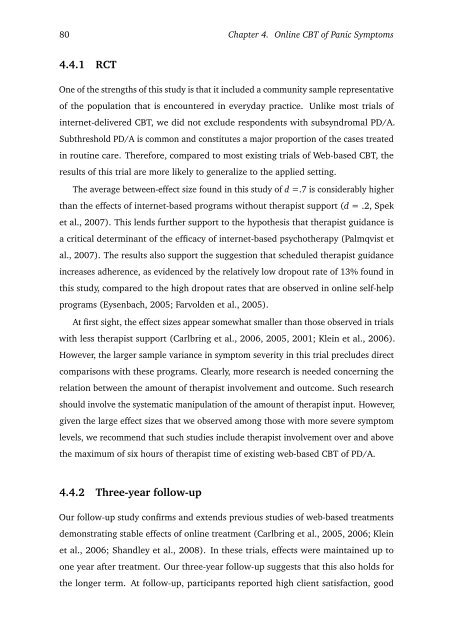The Efficacy and Effectiveness of Online CBT - Jeroen Ruwaard
The Efficacy and Effectiveness of Online CBT - Jeroen Ruwaard
The Efficacy and Effectiveness of Online CBT - Jeroen Ruwaard
- No tags were found...
You also want an ePaper? Increase the reach of your titles
YUMPU automatically turns print PDFs into web optimized ePapers that Google loves.
80 Chapter 4. <strong>Online</strong> <strong>CBT</strong> <strong>of</strong> Panic Symptoms4.4.1 RCTOne <strong>of</strong> the strengths <strong>of</strong> this study is that it included a community sample representative<strong>of</strong> the population that is encountered in everyday practice. Unlike most trials <strong>of</strong>internet-delivered <strong>CBT</strong>, we did not exclude respondents with subsyndromal PD/A.Subthreshold PD/A is common <strong>and</strong> constitutes a major proportion <strong>of</strong> the cases treatedin routine care. <strong>The</strong>refore, compared to most existing trials <strong>of</strong> Web-based <strong>CBT</strong>, theresults <strong>of</strong> this trial are more likely to generalize to the applied setting.<strong>The</strong> average between-effect size found in this study <strong>of</strong> d =.7 is considerably higherthan the effects <strong>of</strong> internet-based programs without therapist support (d = .2, Speket al., 2007). This lends further support to the hypothesis that therapist guidance isa critical determinant <strong>of</strong> the efficacy <strong>of</strong> internet-based psychotherapy (Palmqvist etal., 2007). <strong>The</strong> results also support the suggestion that scheduled therapist guidanceincreases adherence, as evidenced by the relatively low dropout rate <strong>of</strong> 13% found inthis study, compared to the high dropout rates that are observed in online self-helpprograms (Eysenbach, 2005; Farvolden et al., 2005).At first sight, the effect sizes appear somewhat smaller than those observed in trialswith less therapist support (Carlbring et al., 2006, 2005, 2001; Klein et al., 2006).However, the larger sample variance in symptom severity in this trial precludes directcomparisons with these programs. Clearly, more research is needed concerning therelation between the amount <strong>of</strong> therapist involvement <strong>and</strong> outcome. Such researchshould involve the systematic manipulation <strong>of</strong> the amount <strong>of</strong> therapist input. However,given the large effect sizes that we observed among those with more severe symptomlevels, we recommend that such studies include therapist involvement over <strong>and</strong> abovethe maximum <strong>of</strong> six hours <strong>of</strong> therapist time <strong>of</strong> existing web-based <strong>CBT</strong> <strong>of</strong> PD/A.4.4.2 Three-year follow-upOur follow-up study confirms <strong>and</strong> extends previous studies <strong>of</strong> web-based treatmentsdemonstrating stable effects <strong>of</strong> online treatment (Carlbring et al., 2005, 2006; Kleinet al., 2006; Sh<strong>and</strong>ley et al., 2008). In these trials, effects were maintained up toone year after treatment. Our three-year follow-up suggests that this also holds forthe longer term. At follow-up, participants reported high client satisfaction, good


